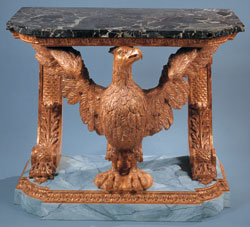 Inspired by the designs of William Kent Inspired by the designs of William Kent
England, circa 1740
Height 33 3/4" Width 42 1/4" Depth 21 1/2"
Courtesy, Clinton Howell Antiques
As a student at the London College of Furniture in the early 1970s, I developed a friendship with a woodcarver. In his workshop, I spotted an unusual console table with a rooster support. I never forgot the table. Just two years ago, I spotted an eagle table at an antiques show and knew it was by the same carver! Then in May 2000, Sotheby's offered a console table with an owl support, and once again I recognized the carver. Recently, someone approached me with the fourth example I've seen of this carver's exciting and masterful work--another eagle table. All four tables are unique and "out-of-the-norm." Each has wonderful faux painting, rear brackets, and a distinctive manner of carving, and each epitomizes the Italianate design expounded by William Kent (1684-1784) as early as 1730.
Of rectangular form, the green marble top rests on a giltwood frieze carved with a band of stylized acanthus leaves and beaded moulding resting on the head of an exquisitely carved and gilded eagle. His wings outspread, his head slightly turned, and his feathers well defined throughout, the bird appears poised for flight. The volute scroll supports to either side are each finely carved with prominent fish-scale ornament terminating in a large acanthus leaf at the foot. The eagle stands on a small base, which in turn rests on a rectangular plinth further embellished with carved acanthus moulding.
This type of marble-slabbed side table with an eagle support would have been referred to as a 'Roman table' in early eighteenth-century pattern books. Designed in the antique manner as a sideboard table for a stone banqueting hall or saloon, the ornament employed was intended to recall ancient poetry such as Ovid's Metamorphoses or Loves of the Gods. As such, the spread eagle would recall its role in bearing away the youthful Ganymede to serve as Jupiter's cup-bearer at the banquet of the Gods.
Eagle tables such as this are often described as being after William Kent (1684-1748), variously described as an architect, painter, landscape gardener, and furniture designer. While the scale and proportion are certainly characteristic of his work, there are no known surviving designs for console tables with eagle supports by Kent. There is however, Kent's illustration for the tail-piece of Alexander Pope's translation of Homer's epic poem, The Odyssey, published in 1725, recounting the history of Rome's foundation after the Trojan wars. The illustration depicts two eagles with outstretched wings, supported by a bracket with a frieze of Greek-key pattern, further embellished with a mask and swags below--the typical form of an eagle console table but reversed.
This eagle console was surely inspired by the work of Kent and exhibits several characteristic elements of English Palladian design. The massive scrolled bracket supports appear in numerous designs for console tables of the period, such as John Vardy's design for a pier table and glass, circa 1745, and relate to several known documented eighteenth-century examples, such as those in the long gallery at Powis Castle, Welshpool, Wales. Furthermore, the quality of the carving can be favorably compared to some of the finest produced during the period, by carvers such as Matthias Lock, Benjamin Goodison, and James Moore the Younger, some of whom are documented as having worked with Kent.
The table has been regilded and the marble replaced.
|